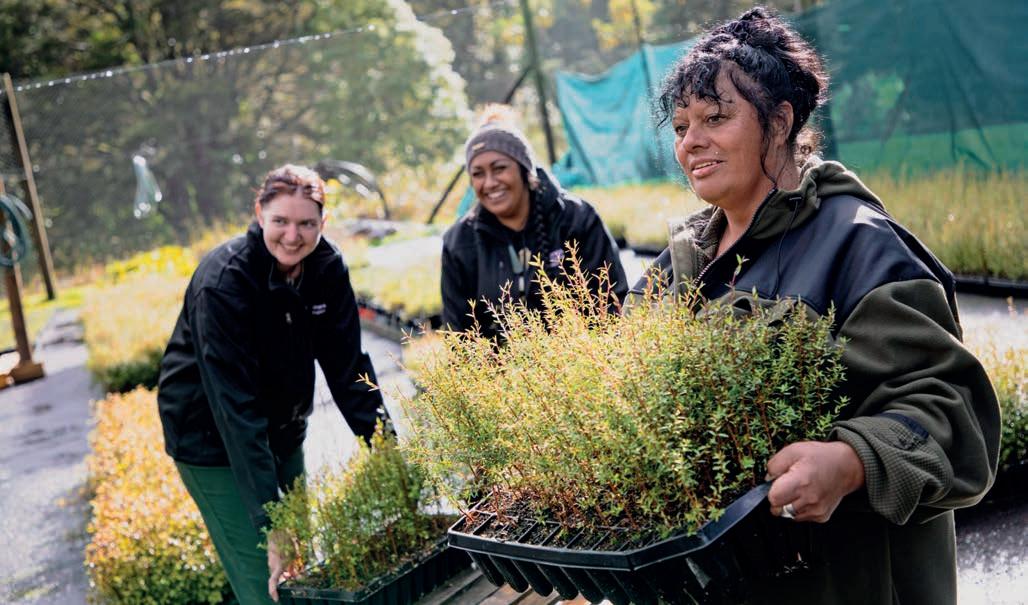
3 minute read
Nursery project puts biosecurity at centre
Restoring 900 hectares in the Waipoua Valley in Northland from exotic forestry to a mosaic of sustainable land uses is a major project. It requires plenty of thought, planning and long-term thinking. Fortunately the Te Toa Whenua initiative by Te Roroa iwi is an ambitious ecological restoration project up to the challenge.
Transforming land returned as part of the Treaty of Waitangi settlement process, Te Toa Whenua seeks to restore and protect the wāhi tapu (sacred place) through eradication of weeds and animal pests and active native forest restoration. “The restoration and environmental health of our whenua and ngahere (native forest) is of utmost importance to Te Toa Whenua so that our future generations will continue this mahi (work) into fruition,” Freda Walker, manager of Te Roroa’s Te Toa Whenua Nursery, says. The Te Toa Whenua Nursery has supplied over 20,000 native tree species for propagation and planting since it began 2 years ago. The nursery establishment and initial operation has been supported by the One Billion Trees programme. By funding end in 2023, the nursery will have capacity to produce 100,000 native seedlings a year. Freda says the project is “hugely rewarding” but not without significant challenges. Top of mind is the sobering reality they are located at ‘ground zero’ of kauri disease, caused by a pathogen called Phytophthora agathidicida. The borders of the former forestry block run along the Waipoua River, adjacent to the iconic Waipoua Kauri Forest. Tāne Mahuta, the world's largest known kauri tree and over 2,000 years old, is only 20km away. “Mana whenua consider these ancient trees our tīpuna. To know that our ancestors are in serious danger is traumatising for us,” Freda says.

| Freda Walker, manager of Te Roroa's Te Toa Whenua Nursery.
“Biosecurity is top of mind in all of the work that we do, not only in our nursery waahi (space) but all over the whenua. “We have created and implemented biosecurity policies and protocols to help protect our ngahere by making sure we are doing everything we can to not be vectors of the spread of any pathogens. We work collaboratively alongside scientific community groups and are at the forefront for any new developments so that we can make the appropriate changes when and if needed.” Due to the sheer scale of the project (900ha) they have had to innovate, such as reforesting using methods such as seed balls and helicopter native seed distribution. For weed management work, the Te Toa Whenua team have employed heavy-duty tools such as excavators to remove ginger and tobacco weed. The biosecurity threats to Te Roroa’s ngahere are multi-faceted, including mammalian pests like pigs and possums and noxious weed species, in addition to plant pathogens such as myrtle rust and the threat of kauri dieback. Te Toa Whenua’s 32km bait station network includes over 700 stations. Knowing how pests travel, it stretches into Waipoua Forest. This ambitious project is not contained just to restoring the 900ha and supporting surrounding whenua; Te Roroa are working with and alongside specialists and technical experts across the country. This includes collaborating with researchers from Lincoln University to run workshops for local tamariki (children) on native plant identification and their uses for rongoā (traditional medicines). “By helping to educate the next generations about the ngahere we can ensure that they will be looked after for years to come,” Frieda says. The project took out an award at the Ministry for Primary Industries 2021 New Zealand Biosecurity Awards. “We are very humbled to have received the award and are honoured to have been given the opportunity to share our story and the highlights of our mahi within the environmental space," Freda says. “Te Toa Whenua is committed to uplifting the aspirations of Te Roroa and strengthening their connections with the whenua. As a people, the success and health of te taiao (nature) is the success and health of Te Roroa. As our people and our community grow, so does the scope and aims of Te Toa Whenua.”





